#File Repository Software System
Explore tagged Tumblr posts
Text
The Best Document Repository Software System
Document management software allows you to store, manage, and access your documents in one central place.
0 notes
Text
Streamline Your Business Operations with PDQ Docs: Centralized Document Management Software
In today’s business environment, managing documents efficiently is crucial for smooth operations. With an increasing volume of digital content, organizations need a robust solution to ensure documents are easily accessible, well-organized, and secure. Centralized document management software like PDQ Docs offers an effective way to address these challenges, providing businesses with a unified platform to manage their documents with ease. By centralizing document storage, retrieval, and collaboration, businesses can streamline operations, improve productivity, and ensure greater security.
What is Centralized Document Management Software?
Centralized document management software refers to a system that consolidates all digital documents and files into one secure, accessible platform. Rather than storing documents in disparate systems or physical locations, businesses can centralize their files into one organized, easy-to-manage repository. With this system, users can access, edit, share, and collaborate on documents from a single interface, ensuring consistency and efficiency across the organization. PDQ Docs is a leading example of centralized document management software that helps businesses organize their documents effectively while offering easy access and improved workflow.

How PDQ Docs Improves Document Management
PDQ Docs simplifies document storage and retrieval by offering a central location where all files are organized and indexed. One of the primary advantages of centralized document management is the ability to search for and retrieve documents quickly. With PDQ Docs, businesses can tag documents with keywords, categories, and metadata, ensuring that files can be located in just a few clicks. Whether it’s a contract, report, or an internal memo, finding documents becomes an efficient process, eliminating the frustration of searching through multiple folders or systems.
Security and Compliance with PDQ Docs
Another significant benefit of centralized document management software is the enhanced security it provides. With PDQ Docs, sensitive information is securely stored in a centralized, encrypted system. Access controls can be set to ensure that only authorized personnel can view or edit specific documents, minimizing the risk of data breaches. This is particularly important for businesses in regulated industries, such as healthcare and finance, where compliance with legal requirements and data protection regulations is paramount.
Why Choose PDQ Docs for Centralized Document Management?
When looking for centralized document management software, PDQ Docs stands out due to its user-friendly interface and powerful features. The software is designed to be intuitive, making it easy for businesses to implement without requiring extensive training. Whether you are a small business or a large corporation, PDQ Docs offers scalable solutions that can grow with your organization’s needs.
Conclusion
Centralized document management software is essential for businesses looking to improve efficiency, collaboration, and security. With PDQ Docs, you can streamline document storage and retrieval, enhance team collaboration, and ensure the security of sensitive information. By centralizing your documents, you’ll have better control over your files, ensuring that your team can access the right documents when needed. Whether you are looking to improve internal workflows or ensure regulatory compliance, PDQ Docs provides a comprehensive solution that will help your business operate more effectively.
#centralized document management software#document management system#digital document storage#enterprise document management#file organization software#document sharing solutions#document retrieval#centralized repository#document archiving#data compliance#document indexing#paperless office
0 notes
Text
Another "Introduction to Piracy" post
There's a few of these going round but they can be dense, spread different information through different reblog chains, and other such impracticalities, so here's a fresh, quick & simple one.
1) Necessary Software
You're going to want two things: a VPN* and a Torrent client. Personally I recommend Mullvad for the former - flat charge of €5/month pay-as-you-go, unlimited data and solid speed, very privacy-focused - and qBitTorrent for the latter.
Once you've installed both of those, you should open qBitTorrent and make sure it only runs through the VPN's internet connection: open Tools in the top bar, then Options->Advanced, and select Mullvad from the Network Interface drop-down box.
*For those unaware, a Virtual Private Network routes your Internet connection through a proxy server and then encrypts it, hiding your activity from your ISP and giving any sites you visit the impression that you're based in whatever country the proxy server is.
2) Finding your desired content
There are many sources of pirated content out there on the Internet, and you can find an awful lot of it on 1337x.to, but personally I always consult the FMHY.net directory, a site dedicated to cataloguing how to find different content by type - films, games, programs etc. If you're worried about the safety of downloading these things, risk of malware and such, honestly you don't really need to be these days - any of the dedicated sites & repositories listed on FMHY should be safe, and if you're going to a general-purpose one like 1337x then as long as the file you want lists a decent number of prior downloads it'll most likely be fine (just avoid The Pirate Bay these days, it is not the haven it was 20 years ago).
3) Downloads
Now, content generally comes in one of two forms: either a direct download, or a torrent. A direct download is exactly what it sounds like, you just receive a copy of the files you want (usually packaged in a ZIP file).
Torrents are a little different. With those, you download a .torrent file, then you open up your torrent client and add it there, then tell it where to save the actual content you want. Torrents are a peer-to-peer download system, meaning instead of downloading the whole file from a specific server you're downloading many parts from everyone else who's previously downloaded it (and is running their torrent client) - this means that how long it takes is entirely dependent on how popular the content in question is, so something obscure and old might take a very long time while a popular new release might be limited only by your internet speed. It also means that you should really keep the .torrent file once your download is finished to help everyone else, an act known as seeding; the alternative, to delete it once you've finished, is known as leeching, and it doesn't harm you but it's generally considered rather impolite.
I think that covers everything, if anyone has any questions or suggestions feel free to say so and I'll update this as needed, until then - hoist your black flag and have fun!
40 notes
·
View notes
Text
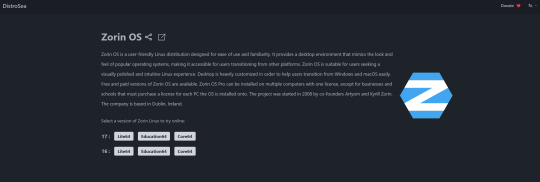
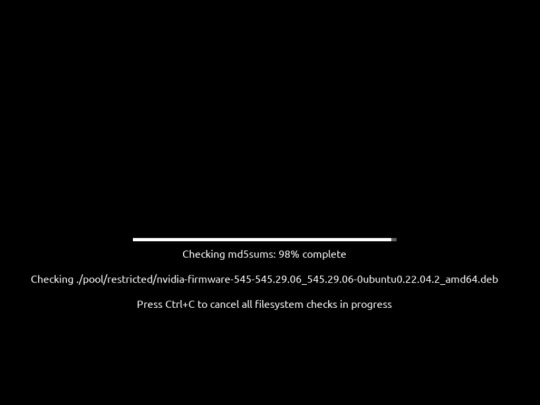
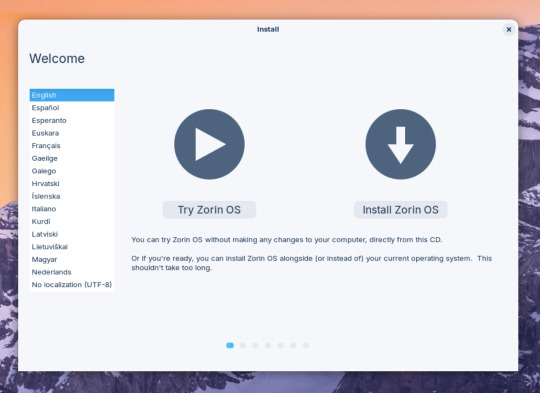

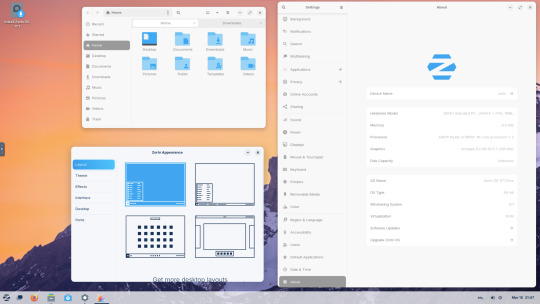


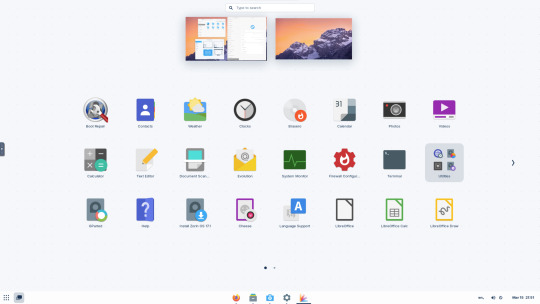
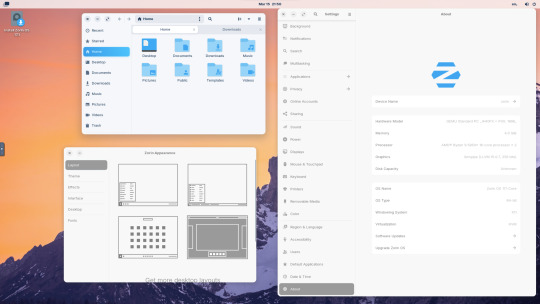
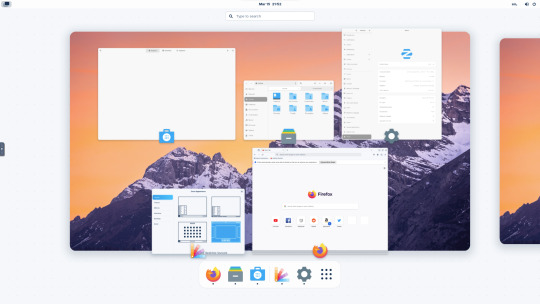

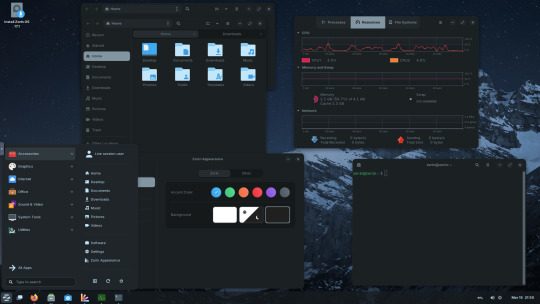


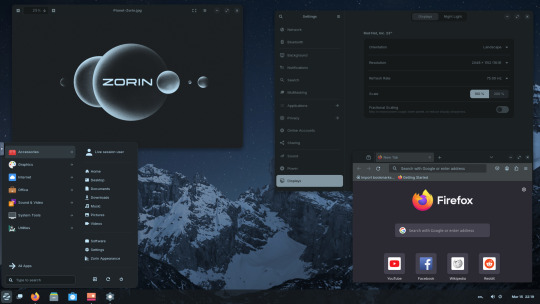
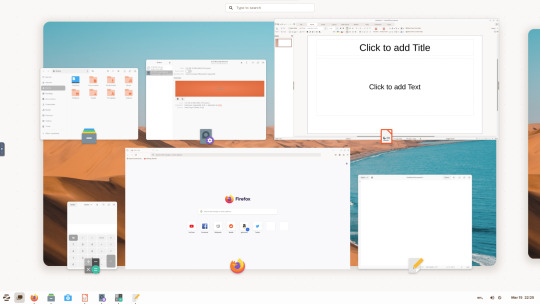
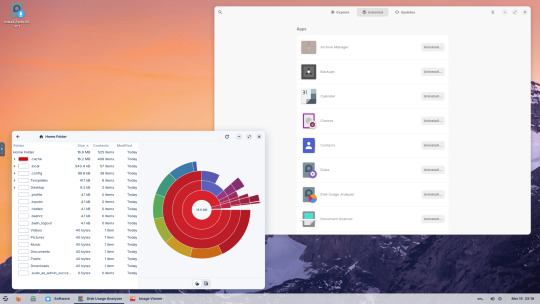
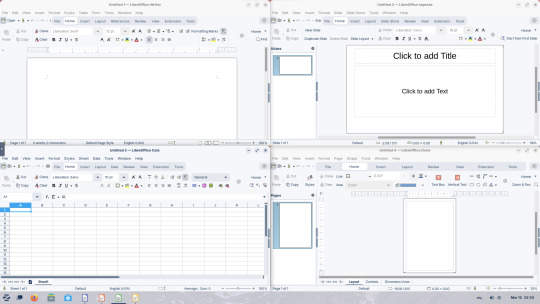
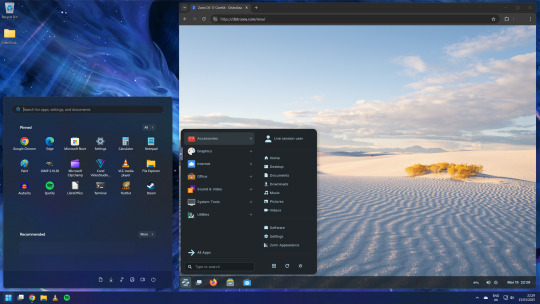

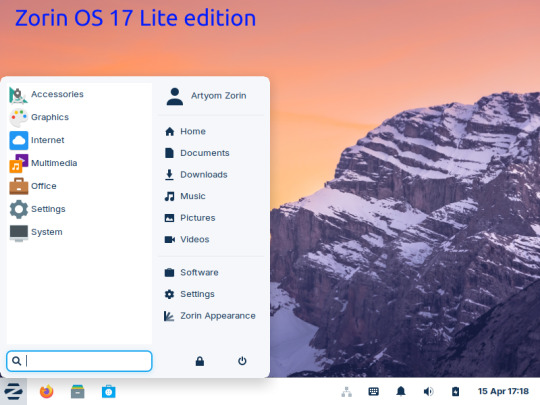
15.03.25
I tried out Zorin OS Linux on Distrosea.
https://distrosea.com/
Zorin OS started its development in 2008 by co-founders Artyom and Kyrill Zorin. The company is based in Dublin, Ireland.
Main site:
https://zorin.com/os/
Wiki link:
https://en.wikipedia.org/wiki/Zorin_OS
Like Linux Mint, it is based on Ubuntu, which in turn is based on Debian and uses the current Ubuntu 24.04.2 LTS base release.
It features the GNOME 3 and XFCE desktop environments and is available in Lite, Education and Core editions.
Due to enhanced performance optimizations in the Core, Pro, and Education editions of Zorin OS, the Lite version is being discontinued.
However the XFCE desktop packages will still be available through the official software repositories:
https://help.zorin.com/docs/getting-started/getting-zorin-os-lite/
I chose version 17 and selected the 'Core' edition.
This version (Core64) features the GNOME desktop and a few more apps. I clicked 'Try' when the Linux distro booted up to the install wizard. The distro performs a md5 sum check before boot-up to check the security of the .iso file.
The distro can be easily customised to echo Windows or MAC-OS, as well as being tweaked to the users preferred layout.
Software can be installed through Zorin's Software Store. applications are available to install in APT, dpkg, Snap and flatpak.
Windows software can be ran using Wine, a compatibly layer for running Windows only programs on Linux, MAC OS and BSD systems.
Zorin OS 17 also comes with various menu layouts from a Windows Classic/7 layout, Windows 11 style layout, GNOME menu and full screen menus. Some of the menu layouts are only available in the paid for Pro edition.
For more about the various layouts and a review see:
https://www.zdnet.com/article/zorin-os-demonstrates-exactly-what-a-desktop-operating-system-should-be/
The panel (referred to as a taskbar) is also highly configurable in size and appearance and can be changed to match the desktop layouts.
Various window management set-ups are featured for tiling windows to the sides of the screen.
I like the operating system as it is both familiar to me as a Windows user, but also is very configurable, features a polished user interface and is easy to navigate. Also Zorin comes with some very striking desktop backgrounds and colours!
However, I couldn't get the VM to connect to the internet, so I couldn't browse Firefox or try out any additional software.
This is just the way that it has been set-up on Distrosea. For test purposes though, it works very well.
It also feels very speedy, even in a virtual machine over the host internet!
4 notes
·
View notes
Text
GitHub and Git Commands: From Beginner to Advanced Level
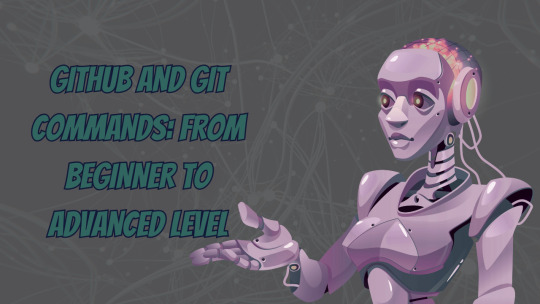
Git and GitHub are essential tools for every developer, whether you're just starting or deep into professional software development. In this blog, we'll break down what Git and GitHub are, why they matter, and walk you through the most essential commands, from beginner to advanced. This guide is tailored for learners who want to master version control and collaborate more effectively on projects.
GitHub and Git Commands
What Is Git?
Git is a distributed version control system created by Linus Torvalds. It allows you to track changes in your code, collaborate with others, and manage your project history.
What Is GitHub?
GitHub is a cloud-based platform built on Git. It allows developers to host repositories online, share code, contribute to open-source projects, and manage collaboration through pull requests, issues, and branches
Why Learn Git and GitHub?
Manage and track code changes efficiently
Collaborate with teams
Roll back to the previous versions of the code
Host and contribute to open-source projects
Improve workflow through automation and branching
Git Installation (Quick Start)
Before using Git commands, install Git from git-scm.com.
Check if Git is installed:
bash
git --version
Beginner-Level Git Commands
These commands are essential for every new user of Git:
1. git init
Initialises a new Git repository.
bash
git init
2. git clone
Clones an existing repository from GitHub.
bash
git clone https://github.com/user/repo.git
3. git status
Checks the current status of files (modified, staged, untracked).
bash
git status
4. git add
Stage changes for commit.
bash
git add filename # stage a specific file git add . # stage all changes
5. git commit
Records changes to the repository.
bash
git commit -m "Your commit message"
6. git push
Pushes changes to the remote repository.
bash
git push origin main # pushes to the main branch
7. git pull
Fetches and merges changes from the remote repository.
bash
git pull origin main
Intermediate Git Commands
Once you’re comfortable with the basics, start using these:
1. git branch
Lists, creates, or deletes branches.
bash
git branch # list branches git branch new-branch # create a new branch
2. git checkout
Switches branches or restores files.
bash
git checkout new-branch
3. git merge
Merges a branch into the current one.
bash
git merge feature-branch
4. git log
Shows the commit history.
bash
git log
5. .gitignore
Used to ignore specific files or folders in your project.
Example .gitignore file:
bash
node_modules/ .env *.log
Advanced Git Commands
Level up your Git skills with these powerful commands:
1. git stash
Temporarily shelves changes not ready for commit.
bash
git stash git stash apply
2. git rebase
Reapplies commits on top of another base tip.
bash
git checkout feature-branch git rebase main
3. git cherry-pick
Apply the changes introduced by an existing commit.
bash
git cherry-pick <commit-hash>
4. git revert
Reverts a commit by creating a new one.
bash
git revert <commit-hash>
5. git reset
Unstages or removes commits.
bash
git reset --soft HEAD~1 # keep changes git reset --hard HEAD~1 # remove changes
GitHub Tips for Projects
Use Readme.md to document your project
Leverage issues and pull requests for collaboration
Add contributors for team-based work
Use GitHub Actions to automate workflows
Final Thoughts
Mastering Git and GitHub is an investment in your future as a developer. Whether you're working on solo projects or collaborating in a team, these tools will save you time and help you maintain cleaner, safer code. Practice regularly and try contributing to open-source projects to strengthen your skills.
Read MORE: https://yasirinsights.com/github-and-git-commands/
2 notes
·
View notes
Text
Engineers for Elon Musk’s so-called Department of Government Efficiency, or DOGE, are working on new software that could assist mass firings of federal workers across government, sources tell WIRED.
The software, called AutoRIF, which stands for Automated Reduction in Force, was first developed by the Department of Defense more than two decades ago. Since then, it’s been updated several times and used by a variety of agencies to expedite reductions in workforce. Screenshots of internal databases reviewed by WIRED show that DOGE operatives have accessed AutoRIF and appear to be editing its code. There is a repository in the Office of Personnel Management’s (OPM) enterprise GitHub system titled “autorif” in a space created specifically for the director’s office—where Musk associates have taken charge—soon after Trump took office. Changes were made as recently as this weekend.
So far, federal agency firings have been conducted manually, with HR officials combing through employee registries and lists provided by managers, sources tell WIRED. Probationary employees—those who were recently hired, promoted, or otherwise changed roles—have been targeted first, as they lack certain civil service protections that would make them harder to fire. Thousands of workers have been terminated over the last few weeks across multiple agencies. With new software and the use of AI, some government employees fear that large-scale terminations could roll out even more quickly.
While DOGE could use AutoRIF as the DOD built it, multiple OPM sources speculated that the Musk-affiliated engineers could be building their own software on top of, or using code from, AutoRIF. In screenshots viewed by WIRED, Riccardo Biasini, a former engineer at Tesla and a director at The Boring Company, has seemingly been tasked with pruning AutoRIF on GitHub, with his name attached to the repository. “Remove obsolete versions of autorif,” one file description authored by a user with Biasini’s username on GitHub says.
Biasini has also been listed as the main point of contact for the government-wide email system created by the Trump administration from within OPM to solicit resignation emails from federal workers.
OPM did not immediately respond to requests for comment from WIRED.
In order to conduct RIFs, government HR officials are required to create lists ranking employees who may be subject to firings. AutoRIF does that automatically, a former government HR official tells WIRED. “However, even with the use of any automated system, the OPM guidance says all data has to be confirmed manually and that employees (or their representative) are allowed to examine the registers.” It’s not immediately clear if AutoRIF’s capabilities have been altered either by the Defense Department or DOGE.
The revelation that DOGE is working on AutoRIF comes as it seemingly prepares for its second major round of firings. On Saturday evening, government workers received yet another email purportedly from OPM demanding that they reply detailing what they accomplished in the last week. Some agencies, like the FBI, asked that employees not respond to the message. In a meeting with HR officials on Monday, OPM told agencies they could ignore the email.
In these emails, government workers were asked to lay out five bullet points explaining their top work achievements of the last week. On Monday, NBC News reported that this information would be fed into an unspecified large language model that would assess whether an employee was necessary.
Before the first round of probationary firings, Centers for Disease Control managers were tasked with marking workers they deemed as “mission critical” and then sending a list of them up the chain of command ahead of firings, a CDC source tells WIRED.
“CDC went through a very, very deliberate effort to characterize our probationary employees as mission critical or not, and that way we could keep those that would have real impacts to the mission should they get terminated,” they say. “None of that was taken into account. They just sent us a list and said, ‘Terminate these employees effective immediately.’”
3 notes
·
View notes
Text
How to install and use IrfanView in Linux - Tutorial
How to install and use IrfanView in Linux - Tutorial
Updated: May 30, 2022
My Windows to Linux migration saga continues. We're still a long way off from finishing it, but it has begun, and I've also outlined a basic list of different programs I will need to try and test in Linux, to make sure when the final switch cometh that I have the required functionality. You can find a fresh bouquet of detailed tutorials on how to get SketchUp, Kerkythea, KompoZer, as well as Notepad++ running in Linux, all of them using WINE and successfully too, in my Linux category.
Today, my focus will be on IrfanView, a small, elegant image viewer for Windows, which I've been using with delight for decades now. It's got everything one needs, and often more than the competitors, hence this bold foray of using it in Linux despite the fact there are tons of native programs available. But let's proceed slowly and not get too far ahead of ourselves. After me.
As I said, it's majestic. A tiny program that does everything. It's fast and extremely efficient. When I posted my software checklist article, a lot of Linux folks said, well, you should try XnView instead. And I did, honest, several times, including just recently, which we will talk about in a separate article, but the endeavor reminded me of why I'd chosen IrfanView all those years back. And those reasons remain.
Then, I did play with pretty much every Linux image viewer out there. None is as good as IrfanView. It comes down to small but important things. For instance, in IrfanView, S will save a file, O will trigger the open dialog. Esc quits the program. Very fast. Most other programs use Ctrl + or Shift + modifiers, and that simply means more actions. I did once try to make GwenView use the full range of Irfan's shortcuts, but then I hit a problem of an ambiguous shortcut, wut. I really don't like the fact that hitting Esc takes you to a thumbnail overview mode. But that's what most programs do.
WINE configuration
The first step is to have WINE installed on your system. I am going to use the exact same method outlined in the SketchUp Make 2017 tutorial. I have the WINE repositories added, and I installed the 6.X branch on my system (at the time of writing).
IrfanView installation
Download the desired 32/64-bit version of the program and then install it. The process should be fast and straightforward. You will be asked to make file type association. You can do this, or simply skip the step, because it doesn't make any difference. You need to associate IrfanView as the default image viewer, if this is your choice, through your distros' file type management utility, whatever it may be.
And the program now works! In Plasma, on top of that, you can also easily pin the icon to the task manager.
Plugins and existing configuration(s)
Much like with Notepad++, you can import your existing workspace from a Windows machine. You can copy plugins into the plugins folder, and the IrfanView INI files into the AppData/Roaming folder. If you don't have any plugins, but you'd like to use some, then you will need to download the IrfanView plugins bundle, extract it, and then selectively, manually copy the plugins into the WINE installation folder. For instance, for the 64-bit version of the program, this is the path:
~/.wine/drive_c/Program Files/IrfanView/Plugins
As a crude example, you may want to make IrfanView be able to open WebP files. In that case, you will need to copy the WebP.dll file into the folder above, and relaunch the program. Or you can copy the entire set of IrfanView plugins. Your choice, of course.
Conclusion
And thus, IrfanView is now part of our growing awesome collection of dependable tools that will make the Windows to Linux migration easier. I am quite sure the Linux purists will be angry by this article, as well as the other tutorials. But the real solution is to develop programs with equivalent if not superior functionality, and then, there will be no reason for any WINE hacks.
If you're an IrfanView user, and you're pondering a move to Linux, then you should be happy with this guide. It shows how to get the program running, and even import old settings and plugins. I've been using IrfanView in Linux for many years, and there have been no problems. That doesn't say anything about the future, of course, but then, if you look at what Windows was 10 years ago, and what it is now, it doesn't really matter. Well, that's the end of our mini-project for today. See you around. More tutorials on the way!
Cheers.
3 notes
·
View notes
Text
Configuring Zephyr: A Deep Dive into Kconfig
We presented The Zephyr Project RTOS and illustrated a personal best practice for beginning with "Zephyr" in an earlier blog post. A custom West manifest file is a great way to guarantee that your code is always at a known baseline when you begin development, as you saw in that blog post. Following the creation of your custom manifest file and the establishment of your baseline repositories using West, what comes next in your Zephyr journey?
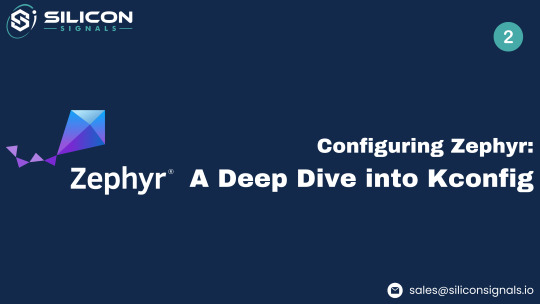
Enabling particular peripherals, features, and subsystems is one of the first steps in putting embedded software into practice. Some MCU manufacturers, like STM32, Microchip, and TI, have tools in their IDEs that let developers add subsystems to their codebase and enable peripherals in their projects. These tools, however, are closely related to the MCUs that the vendors sell. Applying these tools' functionality to other MCUs is challenging, if not impossible.
However, we can enable a specific MCU subsystem or feature using a vendor-neutral mechanism provided by The Zephyr Project RTOS. For people like me who don't like GUIs, this mechanism can be used with a command line. The name of this utility is "Kconfig." I'll go over what Kconfig is, how it functions, and the various ways we can use it to incorporate particular features and subsystems into our Zephyr-based project in this blog post.
WHAT IS KCONFIG?
Kconfig is still utilized today as a component of the kernel compilation process, having been initially created as part of the Linux kernel. Kconfig has a particular grammar. Although fascinating, the specifics of how Kconfig is implemented in the Linux kernel are outside the purview of this blog post. Alternatively, if you're interested, you can read my article here: (https://www.linux-magazine.com/Issues/2021/244/Kconfig-Deep-Dive), which walks through the Kconfig source code. However, after seeing an example, it's simple to become familiar with the format of a "Kconfig"—the slang term for a specific configuration option. The Kconfig system consists of three primary components.
First, there is the collection of Kconfig files scattered across different OS codebase directories. For example, if we look under "drivers/led" within the Zephyr codebase, we see a file named Kconfig with the following contents: menuconfig LED bool "Light-Emitting Diode (LED) drivers" help Include LED drivers in the system configurationif LED...config LED_SHELL bool "LED shell" depends on SHELL help Enable LED shell for testing.source "drivers/led/Kconfig.gpio"...endif # LED
Using the if statement, the line that begins with "menuconfig" tells the Kconfig system that "LED" contains a number of feature options that are only visible if the "LED" feature is enabled. The user can then activate the "LED_SHELL" option if the "LED" feature is enabled. The result of this configuration option is a Boolean, which determines whether this feature is enabled or disabled, as the line that follows shows. If a configuration option refers to a particular configuration parameter, the result can also be an integer in addition to a Boolean. The line that starts with "depends" indicates that in order for the "LED_SHELL" feature to be visible, the "SHELL" feature needs to be enabled. As a result, only after the "LED" and "SHELL" features have been enabled will the "LED_SHELL" feature become visible. A more detailed explanation of the feature can be found in the two lines that begin with "help". Last but not least, the final line before the "endif" lets us refer to additional Kconfig files, which aids in classifying components. As though they were copied and pasted, the features of the referenced file are present in the current file. It is crucial to remember that the path to "source" comes from the Zephyr codebase's root.
HOW SHOULD YOU USE KCONFIG?
A collection of applications that enable users to enable or disable the features listed in all Kconfig files make up the second component of the Kconfig infrastructure. Zephyr provides a Visual Studio Code extension that enables users to carry out this task with a graphical user interface. For command line enthusiasts like myself, the VS Code extension provides an alternative to utilizing a graphical user interface. In order to configure Zephyr appropriately, the extension can accept a file, which is the final component of the Kconfig infrastructure and contains a set of configuration options that can be turned on or off. The following snippet shows an example. CONFIG_BT=yCONFIG_BT_PERIPHERAL=yCONFIG_BT_GATT_CLIENT=yCONFIG_BT_MAX_CONN=1CONFIG_BT_L2CAP_TX_MTU=250CONFIG_BT_BUF_ACL_RX_SIZE=254
There is nothing complicated about the file format. "CONFIG_" appears at the start of each line, and then the configuration option's name. After the "=" symbol, the line either ends with a "y" to activate the feature or a "n" to deactivate it. In the example above, we configure the stack parameters and activate the Bluetooth stack in Zephyr along with specific stack features. "prj. conf," which contains user-defined features, is the default file in the majority of Zephyr-based applications.
CONCLUSION
The Zephyr Project RTOS provides a robust, vendor-neutral mechanism called the Kconfig infrastructure that allows us to fully configure our entire application. It can be used to control particular subsystems and peripherals within the MCU in addition to turning on or off individual stacks within the RTOS and setting configuration parameters.
Ready to bring your embedded systems to life with optimized configurations and robust solutions? We specialize in hardware design and software development tailored to your project needs. Whether you're configuring peripherals or diving deeper into Kconfig for your Zephyr-based applications, our experts are here to support you every step of the way.
👉 Contact Us Today and let's transform your embedded ideas into reality!
2 notes
·
View notes
Text
Optimizing Group Projects with SolidWorks PDM: The Ultimate Collaboration Tool

Group assignments can be challenging, especially in engineering, where collaboration and accuracy are crucial. SolidWorks Product Data Management (PDM) is a powerful tool that streamlines collaborative efforts, making group assignments more efficient and manageable. In this blog, we'll explore how SolidWorks PDM facilitates collaboration, enhances productivity, and ensures project success. We'll also highlight the benefits of seeking the Best Solidworks Assignment Help Online and solidworks Assignment Help to maximize your academic performance.
What is SolidWorks PDM?
SolidWorks PDM is a data management solution that centralizes the storage, organization, and control of project data. It allows multiple users to work on the same project simultaneously while ensuring that everyone has access to the latest information. This system is particularly beneficial for group assignments, where collaboration and version control are essential.
Key Features of SolidWorks PDM
Centralized Data Storage
SolidWorks PDM provides a secure, centralized repository for all project files. This ensures that team members can easily access and share data, reducing the risk of lost or misplaced files.
Version Control
With SolidWorks PDM, every modification is tracked, and previous versions are saved. This feature allows team members to revert to earlier versions if needed and ensures that everyone is working with the most up-to-date information.
Workflow Automation
The workflow automation feature streamlines the approval process. Tasks are automatically assigned, and notifications are sent to the relevant team members, ensuring that projects move forward without unnecessary delays.
Access Control
SolidWorks PDM allows administrators to set permissions for different users, ensuring that only authorized personnel can access sensitive information. This feature helps maintain data security and integrity.
Integration with CAD Software
SolidWorks PDM seamlessly integrates with SolidWorks CAD software, providing a cohesive environment for design and data management. This integration enhances productivity and reduces the likelihood of errors.
Benefits of Using SolidWorks PDM for Group Assignments
1. Enhanced Collaboration
SolidWorks PDM facilitates real-time collaboration among team members. By centralizing data storage and providing version control, it ensures that everyone is working on the same page. Team members can easily share updates and feedback, leading to more efficient project completion.
2. Improved Productivity
The workflow automation feature of SolidWorks PDM streamlines the approval process, reducing bottlenecks and ensuring that projects stay on track. By automating routine tasks, team members can focus on more critical aspects of the project, enhancing overall productivity.
3. Reduced Errors
Version control and access control features of SolidWorks PDM significantly reduce the likelihood of errors. Team members can always access the latest version of a file, and unauthorized changes are prevented. This ensures that the final output is accurate and meets the required standards.
4. Time Savings
With SolidWorks PDM, team members can quickly locate and access the necessary files, reducing the time spent searching for information. Workflow automation further saves time by eliminating manual approval processes. These time savings translate into more efficient project completion and better use of resources.
5. Better Project Management
SolidWorks PDM provides tools for tracking project progress and managing tasks. Team leaders can monitor the status of assignments, identify potential issues, and allocate resources effectively. This leads to better project management and successful completion of group assignments.
Seeking the Best Solidworks Assignment Help Online
While SolidWorks PDM offers numerous benefits for collaborative engineering projects, seeking professional assistance can further enhance your academic performance. The Best Solidworks Assignment Help Online provides expert guidance and support for your group assignments. Here are some reasons to consider seeking solidworks Assignment Help:
Expert Guidance
Professional assignment help services employ experts with extensive knowledge and experience in SolidWorks and PDM. They can provide valuable insights and guidance, helping you understand complex concepts and complete your assignments effectively.
Customized Solutions
Assignment help services offer customized solutions tailored to your specific requirements. Whether you need assistance with a particular aspect of the project or comprehensive support, they can provide the help you need.
Time Management
Balancing multiple assignments and responsibilities can be challenging. Seeking solidworks Assignment Help allows you to manage your time more effectively, ensuring that you can focus on other important tasks without compromising the quality of your work.
Quality Assurance
Professional assignment help services ensure that your assignments are of the highest quality. They provide thorough reviews and edits, ensuring that your final output meets academic standards and is free of errors.
Plagiarism-Free Work
Reputable assignment help services guarantee original, plagiarism-free work. This ensures that your assignments are unique and adhere to academic integrity guidelines.
Conclusion
Collaborative engineering projects can be complex and challenging, but SolidWorks PDM provides the tools necessary to streamline group assignments and enhance productivity. By centralizing data storage, providing version control, automating workflows, and ensuring data security, SolidWorks PDM facilitates efficient collaboration and successful project completion.
In addition to utilizing SolidWorks PDM, seeking the Best Solidworks Assignment Help Online can further enhance your academic performance. Expert guidance, customized solutions, and quality assurance ensure that your assignments meet the highest standards. By combining the benefits of SolidWorks PDM with professional assignment help, you can achieve success in your engineering studies and group projects.
For those looking to maximize their efficiency and productivity in group assignments, integrating SolidWorks PDM and leveraging solidworks Assignment Help is the way to go. This combination provides a comprehensive approach to collaborative engineering, ensuring that you and your team can achieve your academic and project goals with ease.
reference:
#solidworks#assignmenthelp#solidworks assignment help#solidworksassignmenthelp#studentassistance#education#school#academicsuccess
3 notes
·
View notes
Text
A Week of Troubleshooting [My Own Stupidity]
Day 159 - Apr 12th, 12.024
I have been trying to host Forgejo (a lightweight software forge and repository hosting service, forked from Gitea) in my home lab/server for the past week. Falling over and over again and loosing hair because of stress with errors which I can blame anyone besides me. So why not finally tell this little history, since I finally was able to make everything work? Because I really don't know what to feel.
The Context
For these past months I have been working on automating some tasks in my life and career using a home server and various self-hosted services. I won't go into too much detail since it is a topic for another post, but the main piece of this automating system is the Forgejo/Gitea actions feature, similar to GitHub Actions which you probably already know of (and if you don't know or aren't a programmer, just think of it as something that runs tasks automatically for you based on some predefined actions/triggers that you can configure).
My home lab is configured with NixOS, a Linux distro based on the Nix package manager, that lets me configure the whole computer using a single collection of files. The main reason for using this distro is of course the ability to have a portable configuration, which I can use and apply in any computer, but also, another advantage is being able to write and setup everything on a single file format. It is pretty much like writing a cooking book with a collection of recipes organized in categories and the same format, instead of a bunch of sticky notes with different recipes scatted around on some drawer or something. I have been using Nix for a year now on my desktop, so I'm somewhat familiar with it, and my home lab was already running with it hosting some other services like AdGuard Home and Tailscale.
In general, I hadn't a lot of troubles with this setup.
The First Domino Piece
Setting up Forgejo in NixOS is somewhat simple, since it is pretty much a matter of enabling it with:

And it was what I did some months ago when I first settled it up, so I have been using it for hosting some coding projects and backing them up to Codeberg and/or GitHub, without any specific reason, I just like to have and use it.
But then I went to try using Forgejo Actions, and discover that for using them, I needed to set up another service with it, the Forgejo/Gitea Actions Runner. And going through the options, I found the options to enable it, so again, it was a simple matter of doing something like:
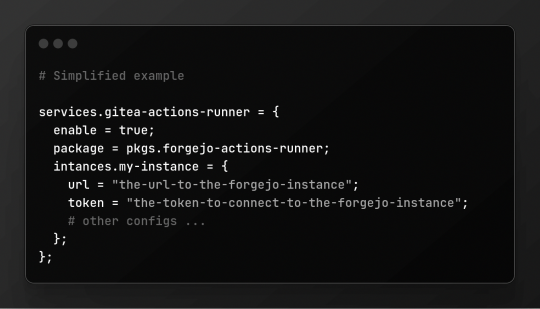
Then, after some issues here and there and just following the documentation, the runner was up. I tested it with some simple scripts, and they ran in their containers successfully. However, there was something which I needed to test, in GitHub/Forgejo/Gitea actions, you need to use an action called "checkout" to get the code from the repository and put it inside the container, so you can run things on top of it and manipulate it as you wish. And obviously I needed it to run my automation scripts and system. So I tested and...

This is not the exact error since I wasn't able to get a screenshot at the time, however the reason was pretty much the same, there was some connection error.
So, I started to tweak my config, and seeing retrospectively, I was lost. The main thing for me at the time was if the error was related to the URL that I used to connect to the Forgejo instance, since because of the Tailscale network on top and the AdGuard Home config, there were five possible URLs that I could use: 192.168.1.13:3030, the local IP on my home's network; localhost:3030, the URL which "makes the server look up its own ports/IP's"; homelab.tailnet-name.ts.net:3030, the readable URL which Tailscale gives for that machine; 100.69.013.10:3030, which is the IP of the home lab on the Tailscale network; And forgejo.homelab.local, a local domain that redirects to the Forgejo instance, configured using Adguard. On top of that, the Forgejo Actions runner has two config values that can affect the URL that the actions, services.forgejo.settings.actions.DEFAULT_ACTIONS_URL and services.gitea-actions-runner.instances.<instance>.url, both of them which I didn't know correctly how they affected the actions.
And so I spend pretty much a whole day just switching combinations, rebuilding and rebuilding the NixOS config, trying different combinations to see if any one of these worked, but nothing. All combinations didn't worked. Nonetheless, there were also Tailscale and Adguard, so I also tried tweaking, enabling and disabling, trying everything that I could to see if they were affecting or not and trying to fix the issue. Installed and removed Forgejo and Forgejo Runner again and again, because as always, I also had customized a lot of things before actually testing them, so I needed to rip out and put together everything to see if I screwed up something, trying to navigate also between the layers of abstractions that I made on the configuration.
And then, I went to bed, after unsuccessfully trying to fix the issue.
On the next day, I pretty much started going directly to the computer. For context, I wanted to finish this setup somewhat quickly to continue my other projects that depended on it, so I started to save time by not doing my normal routine (this probably was one of the worst of my decisions ever). I started to again see if I forgot something, if some configuration on another file was affecting it, and then for some reason that I don't remember anymore, I noticed an option called networking.firewall.allowedTCPPorts, which I had used to enable the ports for AdGuard Home to work...

And like a pass of magic, the checkout action worked and cloned the repository contents.
The Rewrite
After said success, I continue the configuration of the home lab, and things were getting out of control really quickly. I don't know if it is because I learned JavaScript as my first language, but I do tend to try abstract things a lot. In non-technical terms, I tend to hide away a lot of [necessary] complexity under an all-encompassing function or interface, which backfires a lot. And I was doing that with my configuration, trying to join systems with different scopes under the same umbrella, and of course, thing started to get out of control.
And just to kick me more, probably in between all this abstraction and trying to fix the Forgejo Actions... I apparently broke something, which made me unable to connect to Forgejo via SSH. So after one entire day abstracting, the next one I ripped out everything and started to make my NixOS config something more sane and straight forward, and I think that the commit message for this refactor tells a lot about how my mind was:

And after some two more days also migrating my desktop configuration, everything was finally easier to understand and reason about. I did end up forgetting to enable my window and session manager when migrating the desktop config, nothing really difficult to fix using Vim/NeoVim, but I do admire how the computer looks with just the terminal and how many programmers started and maybe to this day program with monitors showing something like this:

Banging My Head Against the Wall
At this point around four days had passed, and it was Tuesday, and I had started all of this on the past week on Friday. All these days, I wasn't having my normal routine or taking a lot of care with myself, going to sleep a lot more late and tired than normal, and even if this month I do need to push my limit, this was a lot more than necessary, and was also affecting my time that I had with my girlfriend, since I couldn't stop thinking about work or have the energy to give attention to her, which also affected my own insecurities and anxiety, feeling like a bad partner to her. Everything because of a god-damn configuration.
However, I didn't want to stop or give up, I love programming, and if I don't make this server work, I won't be able to continue with my plans. So I continued to push, frustrate myself, and bang my head against the wall until this works.
The Forgejo Actions were working, but the SSH push and pull wasn't, and again, because apparently I don't know how to troubleshoot, I started to tweak the config again and again, for another entire day, counting also other issues and problems that I had with the migration. This was something which I acknowledge at the time, but I was feeling and acting lost, never knowing what thing was causing these issues and having tunnel vision. I tried seeing if it was something with what IP I was using, if it was something somehow related to the proxy and AdGuard DNS redirects, and nothing changed. Every time I tried to push or pull via SSH, I got something like fatal: user/repository.git does not appear to be a repository. What was I doing wrong?!?
I forgot to add my SSH Key to the Forgejo user account, that was what I was doing wrong. I fucking should have taken a step back when I noticed that via https it worked as normal, in all IPs or URLs.
But now, remember the checkout action? It wasn't working again. So I did the same fix from before, allowed the TCP port, allowed also for UDP jut in case, and... the same error, ECONNREFUSED. Again, I started by changing the IPs and URLs in the config, however this time, when I used something different from localhost:3030, I got a different output:

And with the foresight of today, I really should have thought a little more why it was a different error, unfortunately I didn't, and started to again write and rewrite config properties, even rewriting the whole Forgejo and Forgejo Actions config, without any success, the day ended, and I have never been so stressed and tired with a project than this.
I really want to be clear that not so many days before all of this, I had a lot of problems and stress with my greater family, problems which really worried about the situation of my parents and the urgency for me to get a job. Thankfully, my parents and I are on a stable situation, and they are really supportive and let me take my time to find a job and hunt what I love, but still, the pressure that I put and need to put on myself to get a job, not only to help my parents, but to also have financial independence and start the first steps in having a home with my partner, all of this was stressing and putting even more weight into this whole thing. Yes, I can find a job without any of these, and I am actively sending resumes where I can, however, this project, server and plan could hopefully really help my situation. And besides all of that, I love programming, I love finding solutions, automating things, seeing the unbelievable amount of progress bars and log streams of processes running, I love this job. So being so.. bad at it, really was hitting my mind.
The day passed, and now it is Friday, the same day that I'm writing this blog post. I fell asleep without even giving goodnight to my girlfriend because of the amount of exhaustion that I had this past night. Thankfully I woke up somewhat on a good mood, even with the stress and exhaustion I was able to get some good sleep and distract myself on the past night to improve my mood in general. However, I needed to fix this issue, already passed an entire week, and fixing or not, I couldn't continue this the next week, I know how much one week can burn out my motivations and love for programming, so, or I fix this, or I change projects and make this a future Guz's problem. At the start it was the same as yesterday, just trying to tweak configurations, even reverting changes to a working state without any success or difference. But then, I started to actually debug this thing, doing something which I really should have done before: test if it is a connection issue or not in the first place. Yes, it is obvious at this point, but when I have tunnel vision on a problem, I really can't think clearly. Nonetheless, I tried using ping to test the connection and...

It wasn't a connection issue... ok... I have to admit that at first glance it just confused me even more, but at least now it isn't a problem with my config? Wait, could it be a problem with the checkout action itself now? How? It was compatible and working with Forgejo without any problems just days ago, and it didn't have any type of update in between these days. I started to search if there was something on the internet about this problem, trying to see if anyone had the ECONNREFUSED problem, but nothing. The Forgejo and Gitea mirrors of the action didn't have anything, nor the issues in the original repository. Maybe it was something related to an API difference between GitHub and Forgejo somehow? The logs say about trying to access an endpoint called /api/v3/repos/{owner}/{repo}/tarball/{ref} to download the archive of the repository, and the "not found" error could be related to some authorization to the endpoint error? Forgejo does show a 404 page when you try to access a private repository or page without authorization, same when you try to clone something via SSH without a key.
Well, I tried to test using curl to the same endpoint, and it returned 404, but the other endpoints didn't... nor in the actions, so it wasn't something with the API it seems...

I went into the Gitea API documentation and... where the fuck is the /tarball endpoint?! It is a GitHub only endpoint! Wait, so why it was working before? What happened? Well, I try to find anything about this endpoint on the GitHub actions, some type of error, or maybe a configuration to use another end point? And for my surprise, searching for "tarball" on the action's repository..

I will hug my girlfriend and cry, brb.
---
Yes, this whole nightmare was because Git wasn't installed on the docker image. And you may be asking why before it didn't use the API fallback? Well, it seems like the official NodeJS debian docker images had Git already installed on them, however, after the rewrite, I started using Gitea's official docker images for actions runner, which don't come with Git preinstalled it seems. And installing Git using apt-get install -y git gave me the confirmation, because the checkout action worked right after it.
Something to Learn in This Chaos
I have been writing this blog post for an entire day now, starting it right after the break to breathe that I needed to have after the action worked.
Foresight really makes me fell stupid right now, not gonna lie. This isn't the first time I'm having this felling, actually in this job is kinda something expected I would say, and the feeling of finally fixing it is rewarding. However, I do feel like it wasn't a healthy way of handling this issue. Again, the pressure I put on myself wasn't helping, and prohibiting me from taking a ten-minute break to rest my mind, really didn't help with the tunnel vision issue, because all the problems that I had were because I wasn't reading the errors correctly and trying to fix things totally unrelated to the problem at hand. And probably, one of the biggest things to me in this entirety, is the fact that I need to learn how to debug problems and narrow the possible causes of them, I wouldn't have known that the problem was Git not being installed, if I didn't have tested the connections with ping and curl on the first place. Will I actually learn because of this experience? Probably not, I will maybe have a lot more weeks of stress until I finally learn and start constructing some muscular memory for this. However, at least now with this blog post, I have somewhere to look back to if I ever need to configure Forgejo again lol.
And, I know that everyone is different and yadda yadda, but having someone with me this entire week, someone which I could rest on her shoulder and calm myself without feeling guilty or something else, someone to talk and have support from, really helped on not going downhill into a harsh burnout I would say. Eu te amo Helena.
Today's artists & creative things Music: Passing Through (Can't the Future Just Wait) - by Kaden MacKay
© 2024 Gustavo "Guz" L. de Mello. Licensed under CC BY-SA 4.0
4 notes
·
View notes
Text
Microsoft believes that the hackers have in recent weeks used information stolen from Microsoft’s corporate email systems to access “some of the company’s source code repositories and internal systems,” the tech firm said in a filing with the US Securities and Exchange Commission(..)
P.S. The Russians have long been openly harming and even waging war against the American West, but the Westerners continue to sleep and pretend that the threat does not exist...!
2 notes
·
View notes
Text
Software Development: Essential Terms for Beginners to Know
Certainly, here are some essential terms related to software development that beginners, including software developers in India, should know:
Algorithm: A step-by-step set of instructions to solve a specific problem or perform a task, often used in programming and data processing.
Code: The written instructions in a programming language that computers can understand and execute.
Programming Language: A formal language used to write computer programs, like Python, Java, C++, etc.
IDE (Integrated Development Environment): A software suite that combines code editor, debugger, and compiler tools to streamline the software development process.
Version Control: The management of changes to source code over time, allowing multiple developers to collaborate on a project without conflicts.
Git: A popular distributed version control system used to track changes in source code during software development.
Repository: A storage location for version-controlled source code and related files, often hosted on platforms like GitHub or GitLab.
Debugging: The process of identifying and fixing errors or bugs in software code.
API (Application Programming Interface): A set of protocols and tools for building software applications. It specifies how different software components should interact.
Framework: A pre-built set of tools, libraries, and conventions that simplifies the development of specific types of software applications.
Database: A structured collection of data that can be accessed, managed, and updated. Examples include MySQL, PostgreSQL, and MongoDB.
Frontend: The user-facing part of a software application, typically involving the user interface (UI) and user experience (UX) design.
Backend: The server-side part of a software application that handles data processing, database interactions, and business logic.
API Endpoint: A specific URL where an API can be accessed, allowing applications to communicate with each other.
Deployment: The process of making a software application available for use, typically on a server or a cloud platform.
DevOps (Development and Operations): A set of practices that aim to automate and integrate the processes of software development and IT operations.
Agile: A project management and development approach that emphasizes iterative and collaborative work, adapting to changes throughout the development cycle.
Scrum: An Agile framework that divides work into time-boxed iterations called sprints and emphasizes collaboration and adaptability.
User Story: A simple description of a feature from the user's perspective, often used in Agile methodologies.
Continuous Integration (CI) / Continuous Deployment (CD): Practices that involve automatically integrating code changes and deploying new versions of software frequently and reliably.
Sprint: A fixed time period (usually 1-4 weeks) in Agile development during which a specific set of tasks or features are worked on.
Algorithm Complexity: The measurement of how much time or memory an algorithm requires to solve a problem based on its input size.
Full Stack Developer: A developer who is proficient in both frontend and backend development.
Responsive Design: Designing software interfaces that adapt and display well on various screen sizes and devices.
Open Source: Software that is made available with its source code, allowing anyone to view, modify, and distribute it.
These terms provide a foundational understanding of software development concepts for beginners, including software developers in India.
#software app#software development#software developers#software development in India#Indian software developers
3 notes
·
View notes
Text
Titan (Final Effect)
Lucy drifted aimlessly through virtual space. This was an ancient part of the InfoNet, a server dedicated to data from the original Remnant System. It was home to countless historical archives and virtual monuments, and she allowed herself to bask in the information they provided.
She was going to be visiting Remnant with Kya soon. The older woman was unyielding in her opinion that every person should have the chance to visit it at least once. They were, after all, the Children of Remnant. What kind of children would they be if they did not visit their mother at least once in their lifetimes?
As she tumbled through an archive of data from the Age of Heroes and swam through an ocean of audiovisual files dedicated to the legends of the past, she became aware of eyes upon her. She looked up and ran a suite of sensory programs to try to identify who was tracking her.
She needn’t have bothered.
A titan made of golden fire appeared above her, a blinding, radiant presence in the InfoNet whose mere presence made her shudder in a combination of awe and terror. Unbidden, a dozen defensive programs spun up, ready to identify and exterminate any attempted breaches or to lead them down rabbit holes of junk data and spam if they couldn’t. Four emergency escape programs loaded. She could forcefully eject herself from the InfoNet if necessary or flee onto one of the fortified servers the Satos maintained as safe houses for explorers operating under their banner.
The golden fire intensified and then settled... into the shape of a lawnmower.
“What the actual fuck?” Lucy muttered.
Kya appeared beside her, the Sato chuckling as she activated a complex identification sequence and hailed the lawnmower. “Don’t mind him. He likes to wander when he’s in maintenance mode, and he’s probably wondering why someone who is not a Sato is exploring the InfoNet under our banner.”
The lawnmower replied with a burst of code so complex that it took almost a minute for Lucy’s translation software to decipher it. The message was surprisingly simple.
Get off my lawn.
“Technically,” Kya drawled. “This isn’t your lawn. This server is under the administration of the Knights of Remnant, and Lucy here has their approval.”
Another burst of code followed, and she once again had to wait a minute or so before she could make heads or tails of it.
They can go screw themselves.
“Hah!” Kya laughed. “You haven’t changed a bit.” She turned. “Come on, Lucy.”
“You’re not worried?” Lucy asked, keeping a close eye on the titanic lawnmower.
“Nah. He’s a big curmudgeon, but he’s mostly harmless unless you’re trying to do anything shady. Trust me. If he wanted you dead, he’d have uploaded a program capable of frying your implants and driving you insane by now. He’s just posturing.”
“Oh.” Lucy followed Kya through a portal, and they re-emerged into a vivid representation of a garden. If she wasn’t mistaken, this place was a repository of information about Beacon, which was one of the places they would be visiting. “Who is he?”
“He’s the lawnmower.”
Lucy blinked. “I know he’s a lawnmower but -”
“No. He’s the lawnmower. You’ve probably heard of Oerba Dia Vanille.” Lucy nodded. Of course, she had. Ever explorer had. Oerba Dia Vanille had been one of the two creators of the InfoNet back during the Age of Heroes. “He is her lawnmower, as in the one that has been around since the Age of Heroes. You know, the one who handles the gardens on Lumina Prime.”
“But... but why is he like that?” Lucy asked.
She had seen Synthetics in the InfoNet, and none of them had possessed the same presence in the InfoNet as the lawnmower.
“I mean... he’s a lawnmower.” Lucy tried to wrap her mind around it and failed.
“He was Oerba Dia Vanille’s lawnmower, and he is the oldest complex artificial intelligence in existence. He even predates Penny Polendina. Since Vanille was never one to do things in half measures, she had him fully equipped for physical and cyber warfare. Her descendants have been upgrading him ever since.” Kya grinned. “The lawnmower is considered an Alpha-One level threat... and he has Tier-One Priority Access to the InfoNet.”
“...” Lucy stared. “You’re joking.”
“Nope.”
“I can’t believe it.”
An Alpha-One level threat was one theoretically capable of breaching all but the most secure strongholds of the InfoNet singlehandedly. Basically, if something wasn’t protected by the Dia-Farron, the Sato, or the Schnee, the lawnmower would be able to break into it. And Tier-One Priority Access? Incredible. The lawnmower had the ability to interface with and access the foundational and essential infrastructure of the InfoNet in a way that was forbidden to all but the most privileged of users.
“What... what does he do with all that power?” Lucy asked.
“Mostly, he just uploads footage and pictures of the gardens,” Kya said. “It’s what he does, and he enjoys doing it. Other than that, he mostly just likes to keep an eye on several parts of the InfoNet. If he sees anything out of line, he investigates it. Depending on what it is, he terminates it or throws it to the Dia-Farron to handle.”
“You wanted me to meet him, didn’t you?” Lucy asked.
“Yep.” Kya nodded. “You’re good, Lucy, very damn good at this. But you need to remember that there is always a bigger fish out there. Some of those fish are largely neutral like the lawnmower. But some of them... well, it’s better you lose any arrogance you might have before you meet them.”
“Like who?” Lucy was curious now.
“ESCHATON is one I hope you never meet.” Kya chuckled. “As you are now, just being near him would probably blank your mind.”
“Who is he?”
“SENTINEL is the Guardian AI the Dia-Farron have tasked with overseeing most of their virtual security. ESCHATON is the swift and terrible sword of the Dia-Farron, a complex AI whose main purpose is to exterminate threats once they have been identified. Basically, he’s the InfoNet equivalent of scorched earth, heads on pikes, and cities on fire. As far as we know, his deployment requires the express approval of both the Supreme Professor and the Supreme Administrator of the Dia-Farron. Outside of them, the only ones who can request his deployment - but not order it - are SENTINEL and the empress.”
“Wow.” Lucy shuddered. “How will I know if ESCHATON is nearby?”
“Oh, trust me. You’ll know. The whole InfoNet usually knows. He’s not exactly subtle.”
5 notes
·
View notes
Text
Discovering a Free Icon Website with the Perfect Trash Can Icon
In the evolving world of digital design, one of the most common needs for creatives, developers, and marketers is access to a high-quality free icon website. Whether you're building an app interface, designing a website, or enhancing a presentation, icons play a crucial role in visual storytelling. Among the wide range of icon categories available, the Free trash can Icon is surprisingly one of the most frequently downloaded due to its utility in interfaces, especially for delete functions and file management features.

When searching for a reliable free icon website, it’s essential to choose one that not only offers a vast library of icons but also ensures consistency in design, compatibility with various platforms, and flexibility in file formats. This is where online resources shine, giving users access to professionally designed icons without the need to create visuals from scratch. For many professionals, this is not just a convenience—it’s a necessity.
Take, for instance, the Free trash can Icon, which appears simple but needs to meet specific criteria. It should be instantly recognizable, blend seamlessly into modern user interfaces, and be available in multiple styles such as flat, outline, or filled. Designers often need to use this icon across different background colors and device screens, which makes having options in terms of resolution and format incredibly important.
The right platform doesn’t just offer volume—it offers variety and quality. On a top-tier free icon website, users can expect icons that align with current design standards. Whether you're looking for a minimalistic version for a sleek, modern interface or a more detailed variant for illustrative purposes, the library typically has multiple options to suit your needs. These icons are usually downloadable in SVG, PNG, EPS, or even webfont formats, allowing easy integration across digital environments.
Another benefit of such platforms is the ability to customize icons before downloading. Designers can often adjust colors, rotate, resize, and even edit certain visual elements to better suit their projects. This level of flexibility enhances workflow efficiency, saving precious time that would otherwise be spent on graphic editing software. For example, when adjusting the Free trash can Icon to match a dark-mode theme or a high-contrast accessibility design, such built-in tools are incredibly useful.
Usability is further enhanced by search filters and tagging systems, helping users find exactly what they need in seconds. This efficiency becomes especially important for teams working on tight deadlines or projects that require rapid iteration. Instead of scouring different platforms or designing icons from scratch, they can rely on a single source that offers trusted, quality assets.
One more significant aspect of using a free icon website is licensing. A reputable site makes licensing terms clear and easy to understand, which is crucial when using assets for commercial or public-facing projects. Whether you’re working on a business website, an e-commerce app, or educational content, you need to be sure your use of the Free trash can Icon and other graphics doesn’t violate copyright or licensing terms.
Beyond just individual users, such icon platforms benefit agencies, startups, and development firms that require large-scale access to visual assets. A comprehensive icon repository with free access is a cost-effective solution that doesn’t compromise on design quality. It empowers creators to maintain professional standards without inflating project budgets.
In addition, the platform’s responsive user interface and regular updates mean that users always have access to the latest trends in design. Icon styles evolve over time, and having fresh, up-to-date content ensures your visuals stay modern. For instance, the Free trash can Icon may be available in a newly released gradient style or with subtle 3D shading to match the look of contemporary interfaces.
Design is all about communication, and icons are a visual shorthand that helps users interact with technology effortlessly. With access to a trusted free icon website, professionals can enhance user experiences, build beautiful products, and keep workflows efficient—all without the burden of additional costs or extended production timelines.
In conclusion, platforms like this serve as a creative toolbox for digital professionals. From sourcing a basic yet essential Free trash can Icon to exploring thousands of other visual assets, the value they bring to the design process is undeniable. With only a few clicks, designers, developers, and content creators unlock an entire world of possibility—streamlining their work and elevating their final product.
0 notes
Text
Transforming Legal Operations: iManage Solutions for Modern Law Firms
In the evolving digital landscape, legal professionals face increasing demands for secure, organized, and efficient document and email management. That’s where iManage steps in. As the industry leader in legal document management, iManage empowers law firms and corporate legal departments with robust tools for handling files, emails, and workflows. Whether you're interested in the latest iManage software update or looking to streamline operations with iManage Worksite Web, MacroAgility Inc. delivers tailored iManage solutions to meet your unique needs.
What Is iManage?
iManage is a secure, AI-powered document and email management platform designed for legal, accounting, and financial services professionals. Its core platform, iManage Worksite, allows teams to collaborate, manage risk, and work smarter through enhanced workflows and centralized access to files and communications.
To get the most from your investment, MacroAgility Inc. provides full-service iManage support, deployment, and consulting through its team of certified experts.
iManage for Law Firms: Boosting Productivity & Compliance
Today’s law firms need more than just digital storage — they need seamless access, version control, and compliance-ready systems. iManage for law firms enhances legal workflows by offering:
Centralized document and email storage
Audit trails for compliance
Secure collaboration features
Cloud and on-premise deployment options
With MacroAgility's legal document management services, firms can implement, migrate, or optimize their imanaged solutions and confidently.
Introducing iManage White Rabbit & Bulk Import
iManage continues to innovate, and tools like iManage White Rabbit simplify large-scale data imports. This automation tool is especially beneficial during system upgrades or transitions from legacy platforms.
iManage bulk import capabilities allow your IT teams or consultants to efficiently bring in legacy data, client files, and historical emails — minimizing manual effort and maximizing accuracy. MacroAgility’s iManage Work consultants specialize in managing such transitions with minimal disruption.
iManage Worksite & Web Access
iManage Worksite is the backbone of the system — giving users structured access to all legal content. With iManage Worksite Web, you get that same powerful functionality in a web-based interface. This enables remote work and global collaboration while maintaining full compliance and security.
To ensure smooth performance and accessibility, MacroAgility offers consulting and support for configuring and customizing Worksite deployments.
iManage Worksite Jobs & Automation
Managing daily administrative tasks can be overwhelming for legal IT teams. That’s where iManage Worksite Jobs come in — automated background processes that ensure your repositories remain updated, synchronized, and secure. Common Worksite jobs include indexing, backup verification, and permission updates.
At MacroAgility, we help clients set up and monitor these jobs for optimal performance and zero downtime.
Staying Current: Latest iManage Software Update
With each litigation document management, users benefit from performance enhancements, new security protocols, and UI improvements. Staying updated is vital for security and productivity.
MacroAgility’s consultants help your organization implement these updates seamlessly — with minimal interruption to your daily operations.
Specialized Solutions: iManage at Macquarie
Institutions like Macquarie utilize customized iManage implementations to streamline financial and legal processes across departments. Their use case highlights iManage’s scalability for large, international enterprises.
At MacroAgility, we craft tailored solutions like these to fit your firm's size, scope, and regulatory requirements.
Why Choose MacroAgility for Your iManage Needs?
As a premier partner for imanage macquarie and legal technology consulting, MacroAgility Inc. stands out by offering:
Deep expertise across all iManage modules
Custom integrations and automation
White-glove onboarding and support
Performance optimization and compliance solutions
Whether you're migrating to iManage, upgrading to the latest version, or deploying iManage iSearch UI for enhanced search functionality, we’ve got you covered.
Ready to Future-Proof Your Legal Operations?
Empower your team with cutting-edge document and email management. Let MacroAgility Inc. help you unlock the full potential of iManage today.
📞 Contact us for a free iManage consultation!
0 notes
Text
The Power of Document Management Software: Boosting Efficiency and Security
In today’s fast-paced business world, information is power. But what happens when that information is buried under piles of paper, scattered across various drives, or difficult to track? The answer is a significant drain on productivity, increased security risks, and a whole lot of frustration. This is where Document Management Software (DMS) comes to the rescue, revolutionizing how businesses handle their crucial information.
What is Document Management Software?
At its core, Document Management Software is a system designed to manage and organize documents and digital files. Think of it as a central hub for all your business’s documents — from invoices and contracts to HR records and marketing materials. It allows you to store, track, retrieve, and share documents electronically, eliminating the need for physical filing cabinets and manual processes.
Introducing Smart DM — Your Intelligent Document Management Solution
We are thrilled to introduce Smart DM, a robust and intuitive Document Management Software from Smart Factory India, specifically designed to empower your business with streamlined document workflows and enhanced security. Smart DM is more than just a storage solution; it’s a comprehensive platform built to transform your document handling.
Features That Set Smart DM Apart
Smart DM is packed with features that cater to the diverse needs of modern businesses:
Centralized Repository: Store all your documents in one secure, easily accessible location. No more searching through disparate folders or physical archives.
Version Control: Keep track of every revision with automatic versioning. Always ensure you’re working on the latest document and easily revert to previous versions if needed.
Advanced Search & Retrieval: Find any document in seconds with powerful search capabilities, including full-text search and metadata filtering.
Workflow Automation: Automate routine document processes like approvals, reviews, and distribution, reducing manual effort and errors.
Robust Security & Access Control: Protect sensitive information with granular access permissions, encryption, and audit trails. Control who sees what and track every document interaction.
Collaboration Tools: Facilitate seamless collaboration on documents with features like co-authoring, annotations, and shared workspaces.
Integration Capabilities: Easily integrate Smart DM with your existing business applications for a unified operational environment.
Mobile Accessibility: Access your documents anytime, anywhere, from any device, empowering your team with flexibility and remote work capabilities.
Key Benefits of Smart DM Document Management Software
Implementing Smart DM can bring a multitude of tangible benefits to your organization:
Boosted Efficiency & Productivity
Enhanced Security & Compliance
Cost Savings
Improved Collaboration & Communication:
Better Decision-Making
Conclusion
In an era where digital transformation is paramount, a robust Document Management Software like Smart DM is no longer a luxury but a necessity. By investing in Smart DM, your business can unlock unparalleled efficiency, bolster security, foster collaboration, and ultimately, gain a significant competitive edge.

0 notes